service interval MITSUBISHI GRANDIS 2008 Owner's Manual (in English)
[x] Cancel search | Manufacturer: MITSUBISHI, Model Year: 2008, Model line: GRANDIS, Model: MITSUBISHI GRANDIS 2008Pages: 458, PDF Size: 18.52 MB
Page 167 of 458
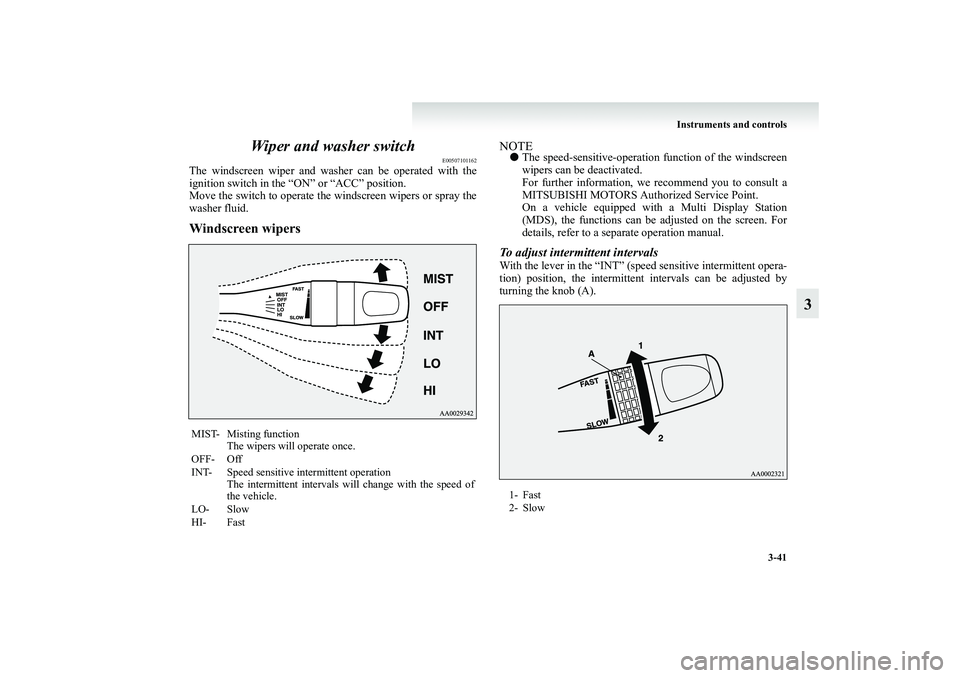
Instruments and controls
3-41
3 Wiper and washer switch
E00507101162
The windscreen wiper and washer can be operated with the
ignition switch in the “ON” or “ACC” position.
Move the switch to operate the windscreen wipers or spray the
washer fluid.Windscreen wipers
NOTE●The speed-sensitive-operation function of the windscreen
wipers can be deactivated.
For further information, we recommend you to consult a
MITSUBISHI MOTORS Authorized Service Point.
On a vehicle equipped with a Multi Display Station
(MDS), the functions can be adjusted on the screen. For
details, refer to a separate operation manual.To adjust intermittent intervalsWith the lever in the “INT” (speed sensitive intermittent opera-
tion) position, the intermittent intervals can be adjusted by
turning the knob (A).
MIST- Misting function
The wipers will operate once.
OFF- Off
INT- Speed sensitive intermittent operation
The intermittent intervals will change with the speed of
the vehicle.
LO- Slow
HI- Fast
1- Fast
2- Slow
BK-XP08E1ENUK.en-uk.book Page 41 Monday, August 13, 2007 2:20 PM
Page 169 of 458
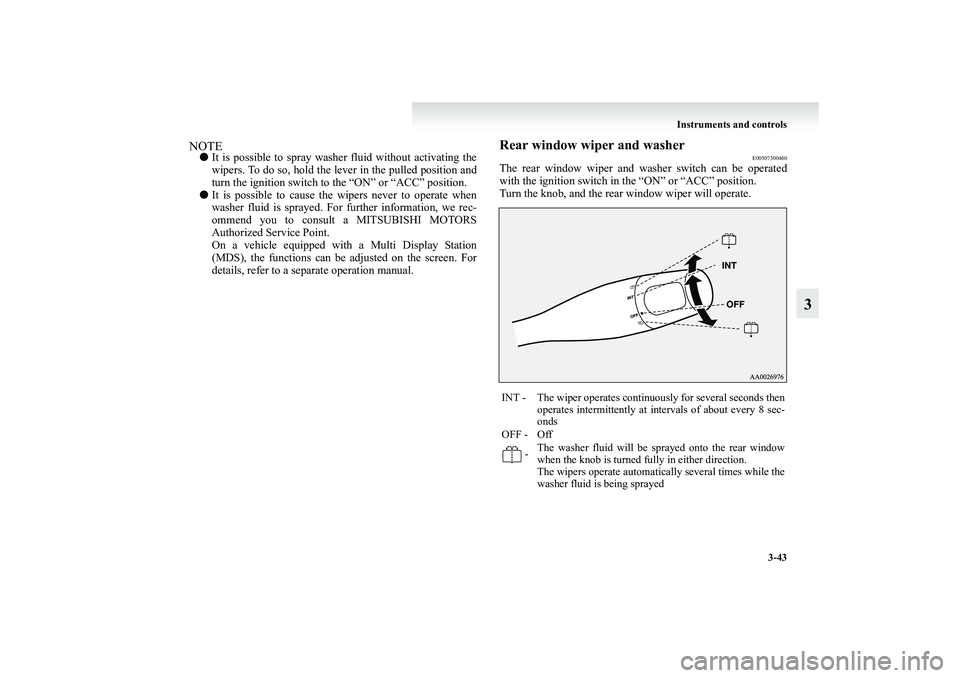
Instruments and controls
3-43
3
NOTE●It is possible to spray washer fluid without activating the
wipers. To do so, hold the lever in the pulled position and
turn the ignition switch to the “ON” or “ACC” position.
●It is possible to cause the wipers never to operate when
washer fluid is sprayed. For further information, we rec-
ommend you to consult a MITSUBISHI MOTORS
Authorized Service Point.
On a vehicle equipped with a Multi Display Station
(MDS), the functions can be adjusted on the screen. For
details, refer to a separate operation manual.
Rear window wiper and washer
E00507300460
The rear window wiper and washer switch can be operated
with the ignition switch in the “ON” or “ACC” position.
Turn the knob, and the rear window wiper will operate.INT - The wiper operates continuously for several seconds then
operates intermittently at intervals of about every 8 sec-
onds
OFF - Off
-The washer fluid will be sprayed onto the rear window
when the knob is turned fully in either direction.
The wipers operate automatically several times while the
washer fluid is being sprayed
BK-XP08E1ENUK.en-uk.book Page 43 Monday, August 13, 2007 2:20 PM
Page 170 of 458
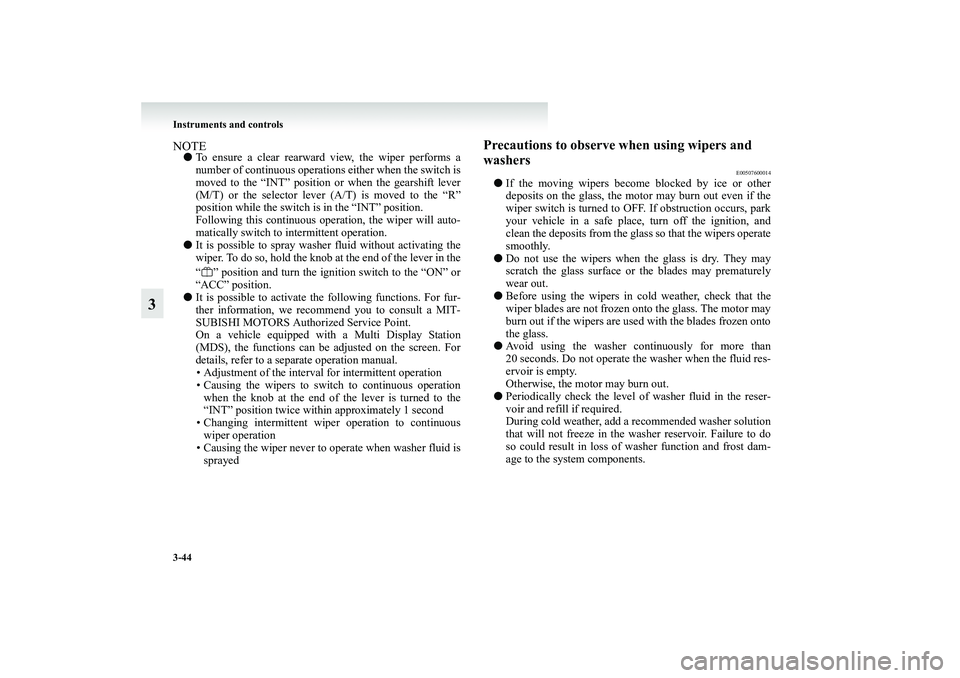
3-44 Instruments and controls
3
NOTE●To ensure a clear rearward view, the wiper performs a
number of continuous operations either when the switch is
moved to the “INT” position or when the gearshift lever
(M/T) or the selector lever (A/T) is moved to the “R”
position while the switch is in the “INT” position.
Following this continuous operation, the wiper will auto-
matically switch to intermittent operation.
●It is possible to spray washer fluid without activating the
wiper. To do so, hold the knob at the end of the lever in the
“ ” position and turn the ignition switch to the “ON” or
“ACC” position.
●It is possible to activate the following functions. For fur-
ther information, we recommend you to consult a MIT-
SUBISHI MOTORS Authorized Service Point.
On a vehicle equipped with a Multi Display Station
(MDS), the functions can be adjusted on the screen. For
details, refer to a separate operation manual.
• Adjustment of the interval for intermittent operation
• Causing the wipers to switch to continuous operation
when the knob at the end of the lever is turned to the
“INT” position twice within approximately 1 second
• Changing intermittent wiper operation to continuous
wiper operation
• Causing the wiper never to operate when washer fluid is
sprayed
Precautions to observe when using wipers and
washers
E00507600014
●If the moving wipers become blocked by ice or other
deposits on the glass, the motor may burn out even if the
wiper switch is turned to OFF. If obstruction occurs, park
your vehicle in a safe place, turn off the ignition, and
clean the deposits from the glass so that the wipers operate
smoothly.
●Do not use the wipers when the glass is dry. They may
scratch the glass surface or the blades may prematurely
wear out.
●Before using the wipers in cold weather, check that the
wiper blades are not frozen onto the glass. The motor may
burn out if the wipers are used with the blades frozen onto
the glass.
●Avoid using the washer continuously for more than
20 seconds. Do not operate the washer when the fluid res-
ervoir is empty.
Otherwise, the motor may burn out.
●Periodically check the level of washer fluid in the reser-
voir and refill if required.
During cold weather, add a recommended washer solution
that will not freeze in the washer reservoir. Failure to do
so could result in loss of washer function and frost dam-
age to the system components.
BK-XP08E1ENUK.en-uk.book Page 44 Monday, August 13, 2007 2:20 PM
Page 174 of 458
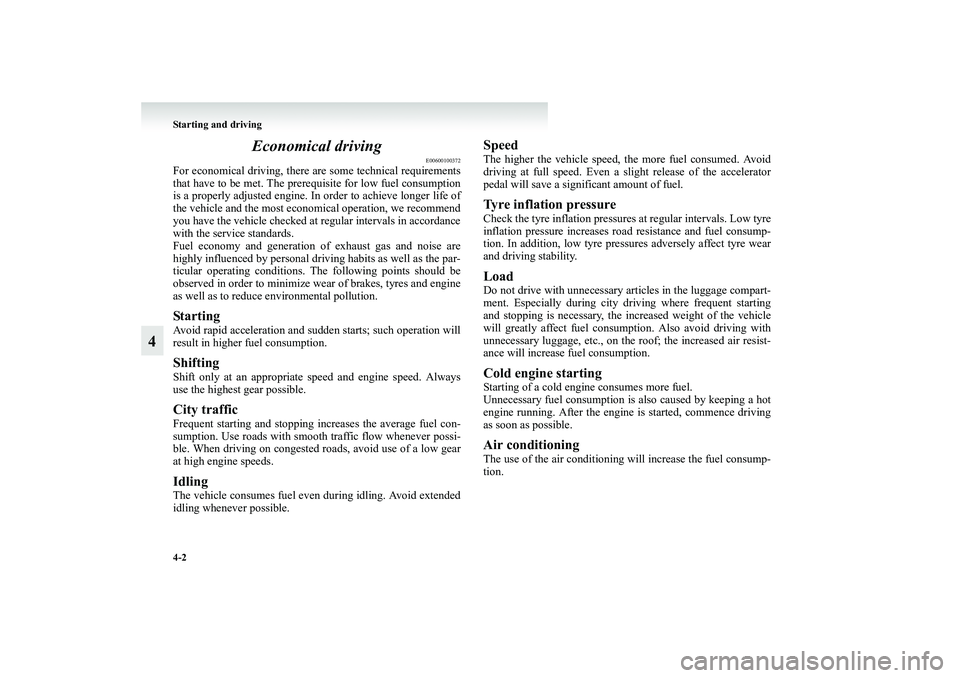
4-2 Starting and driving
4Economical driving
E00600100372
For economical driving, there are some technical requirements
that have to be met. The prerequisite for low fuel consumption
is a properly adjusted engine. In order to achieve longer life of
the vehicle and the most economical operation, we recommend
you have the vehicle checked at regular intervals in accordance
with the service standards.
Fuel economy and generation of exhaust gas and noise are
highly influenced by personal driving habits as well as the par-
ticular operating conditions. The following points should be
observed in order to minimize wear of brakes, tyres and engine
as well as to reduce environmental pollution.StartingAvoid rapid acceleration and sudden starts; such operation will
result in higher fuel consumption.ShiftingShift only at an appropriate speed and engine speed. Always
use the highest gear possible.City trafficFrequent starting and stopping increases the average fuel con-
sumption. Use roads with smooth traffic flow whenever possi-
ble. When driving on congested roads, avoid use of a low gear
at high engine speeds.IdlingThe vehicle consumes fuel even during idling. Avoid extended
idling whenever possible.
SpeedThe higher the vehicle speed, the more fuel consumed. Avoid
driving at full speed. Even a slight release of the accelerator
pedal will save a significant amount of fuel.Tyre inflation pressureCheck the tyre inflation pressures at regular intervals. Low tyre
inflation pressure increases road resistance and fuel consump-
tion. In addition, low tyre pressures adversely affect tyre wear
and driving stability.LoadDo not drive with unnecessary articles in the luggage compart-
ment. Especially during city driving where frequent starting
and stopping is necessary, the increased weight of the vehicle
will greatly affect fuel consumption. Also avoid driving with
unnecessary luggage, etc., on the roof; the increased air resist-
ance will increase fuel consumption.Cold engine startingStarting of a cold engine consumes more fuel.
Unnecessary fuel consumption is also caused by keeping a hot
engine running. After the engine is started, commence driving
as soon as possible.Air conditioningThe use of the air conditioning will increase the fuel consump-
tion.
BK-XP08E1ENUK.en-uk.book Page 2 Monday, August 13, 2007 2:20 PM
Page 207 of 458
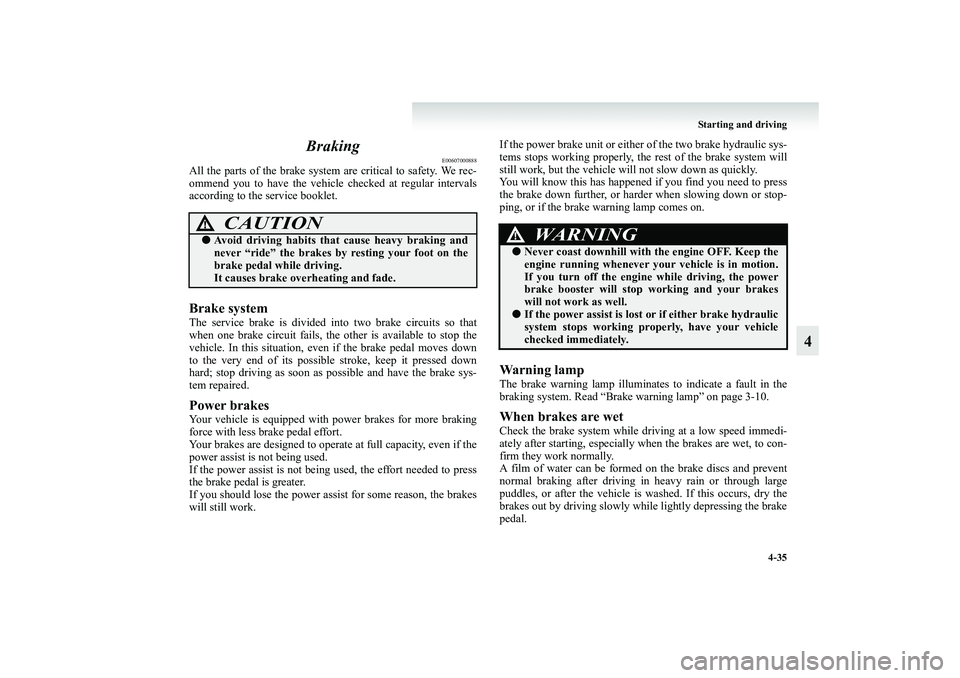
Starting and driving
4-35
4 Braking
E00607000888
All the parts of the brake system are critical to safety. We rec-
ommend you to have the vehicle checked at regular intervals
according to the service booklet.Brake systemThe service brake is divided into two brake circuits so that
when one brake circuit fails, the other is available to stop the
vehicle. In this situation, even if the brake pedal moves down
to the very end of its possible stroke, keep it pressed down
hard; stop driving as soon as possible and have the brake sys-
tem repaired.Power brakesYour vehicle is equipped with power brakes for more braking
force with less brake pedal effort.
Your brakes are designed to operate at full capacity, even if the
power assist is not being used.
If the power assist is not being used, the effort needed to press
the brake pedal is greater.
If you should lose the power assist for some reason, the brakes
will still work.If the power brake unit or either of the two brake hydraulic sys-
tems stops working properly, the rest of the brake system will
still work, but the vehicle will not slow down as quickly.
You will know this has happened if you find you need to press
the brake down further, or harder when slowing down or stop-
ping, or if the brake warning lamp comes on.
Wa r n i n g l a m pThe brake warning lamp illuminates to indicate a fault in the
braking system. Read “Brake warning lamp” on page 3-10.When brakes are wetCheck the brake system while driving at a low speed immedi-
ately after starting, especially when the brakes are wet, to con-
firm they work normally.
A film of water can be formed on the brake discs and prevent
normal braking after driving in heavy rain or through large
puddles, or after the vehicle is washed. If this occurs, dry the
brakes out by driving slowly while lightly depressing the brake
pedal.
CAUTION
!●Avoid driving habits that cause heavy braking and
never “ride” the brakes by resting your foot on the
brake pedal while driving.
It causes brake overheating and fade.
WARNING
!●Never coast downhill with the engine OFF. Keep the
engine running whenever your vehicle is in motion.
If you turn off the engine while driving, the power
brake booster will stop working and your brakes
will not work as well.●If the power assist is lost or if either brake hydraulic
system stops working properly, have your vehicle
checked immediately.
BK-XP08E1ENUK.en-uk.book Page 35 Monday, August 13, 2007 2:20 PM
Page 254 of 458
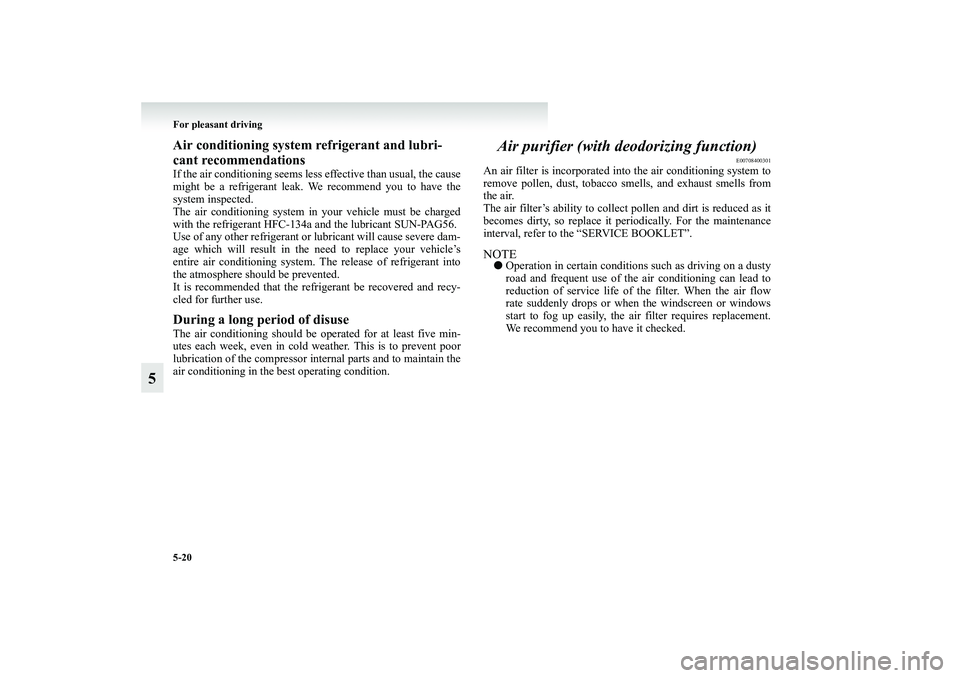
5-20 For pleasant driving
5
Air conditioning system refrigerant and lubri-
cant recommendationsIf the air conditioning seems less effective than usual, the cause
might be a refrigerant leak. We recommend you to have the
system inspected.
The air conditioning system in your vehicle must be charged
with the refrigerant HFC-134a and the lubricant SUN-PAG56.
Use of any other refrigerant or lubricant will cause severe dam-
age which will result in the need to replace your vehicle’s
entire air conditioning system. The release of refrigerant into
the atmosphere should be prevented.
It is recommended that the refrigerant be recovered and recy-
cled for further use.During a long period of disuseThe air conditioning should be operated for at least five min-
utes each week, even in cold weather. This is to prevent poor
lubrication of the compressor internal parts and to maintain the
air conditioning in the best operating condition.
Air purifier (with deodorizing function)
E00708400301
An air filter is incorporated into the air conditioning system to
remove pollen, dust, tobacco smells, and exhaust smells from
the air.
The air filter’s ability to collect pollen and dirt is reduced as it
becomes dirty, so replace it periodically. For the maintenance
interval, refer to the “SERVICE BOOKLET”.NOTE●Operation in certain conditions such as driving on a dusty
road and frequent use of the air conditioning can lead to
reduction of service life of the filter. When the air flow
rate suddenly drops or when the windscreen or windows
start to fog up easily, the air filter requires replacement.
We recommend you to have it checked.
BK-XP08E1ENUK.en-uk.book Page 20 Monday, August 13, 2007 2:20 PM
Page 358 of 458
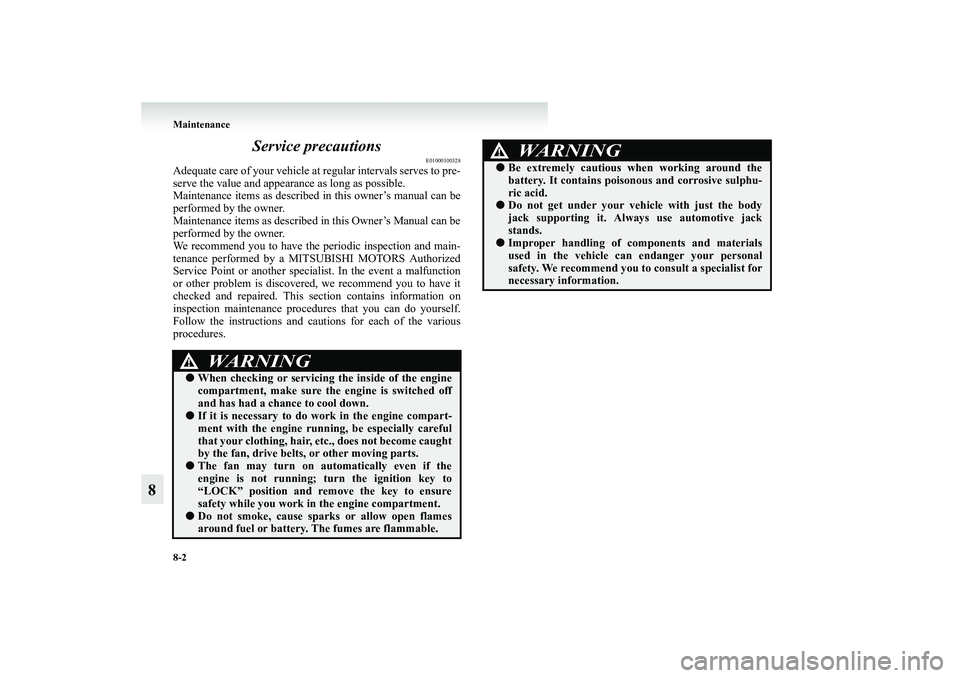
8-2 Maintenance
8Service precautions
E01000100328
Adequate care of your vehicle at regular intervals serves to pre-
serve the value and appearance as long as possible.
Maintenance items as described in this owner’s manual can be
performed by the owner.
Maintenance items as described in this Owner’s Manual can be
performed by the owner.
We recommend you to have the periodic inspection and main-
tenance performed by a MITSUBISHI MOTORS Authorized
Service Point or another specialist. In the event a malfunction
or other problem is discovered, we recommend you to have it
checked and repaired. This section contains information on
inspection maintenance procedures that you can do yourself.
Follow the instructions and cautions for each of the various
procedures.
WARNING
!●When checking or servicing the inside of the engine
compartment, make sure the engine is switched off
and has had a chance to cool down.●If it is necessary to do work in the engine compart-
ment with the engine running, be especially careful
that your clothing, hair, etc., does not become caught
by the fan, drive belts, or other moving parts.●The fan may turn on automatically even if the
engine is not running; turn the ignition key to
“LOCK” position and remove the key to ensure
safety while you work in the engine compartment.●Do not smoke, cause sparks or allow open flames
around fuel or battery. The fumes are flammable.
●Be extremely cautious when working around the
battery. It contains poisonous and corrosive sulphu-
ric acid.●Do not get under your vehicle with just the body
jack supporting it. Always use automotive jack
stands.●Improper handling of components and materials
used in the vehicle can endanger your personal
safety. We recommend you to consult a specialist for
necessary information.
WARNING
!
BK-XP08E1ENUK.en-uk.book Page 2 Monday, August 13, 2007 2:20 PM
Page 364 of 458
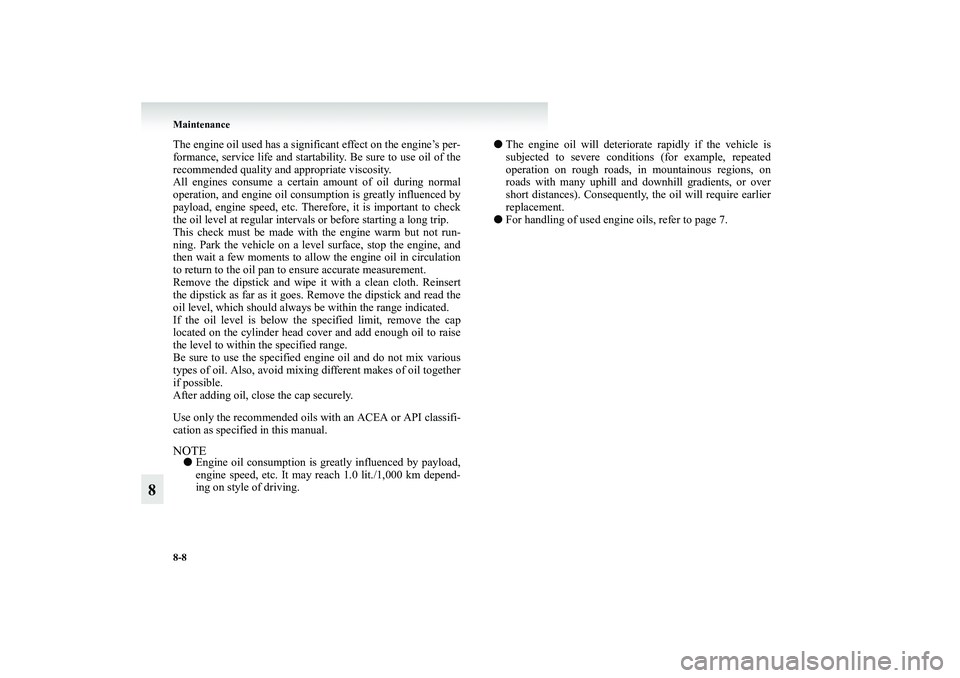
8-8 Maintenance
8
The engine oil used has a significant effect on the engine’s per-
formance, service life and startability. Be sure to use oil of the
recommended quality and appropriate viscosity.
All engines consume a certain amount of oil during normal
operation, and engine oil consumption is greatly influenced by
payload, engine speed, etc. Therefore, it is important to check
the oil level at regular intervals or before starting a long trip.
This check must be made with the engine warm but not run-
ning. Park the vehicle on a level surface, stop the engine, and
then wait a few moments to allow the engine oil in circulation
to return to the oil pan to ensure accurate measurement.
Remove the dipstick and wipe it with a clean cloth. Reinsert
the dipstick as far as it goes. Remove the dipstick and read the
oil level, which should always be within the range indicated.
If the oil level is below the specified limit, remove the cap
located on the cylinder head cover and add enough oil to raise
the level to within the specified range.
Be sure to use the specified engine oil and do not mix various
types of oil. Also, avoid mixing different makes of oil together
if possible.
After adding oil, close the cap securely.
Use only the recommended oils with an ACEA or API classifi-
cation as specified in this manual.NOTE●Engine oil consumption is greatly influenced by payload,
engine speed, etc. It may reach 1.0 lit./1,000 km depend-
ing on style of driving.●The engine oil will deteriorate rapidly if the vehicle is
subjected to severe conditions (for example, repeated
operation on rough roads, in mountainous regions, on
roads with many uphill and downhill gradients, or over
short distances). Consequently, the oil will require earlier
replacement.
●For handling of used engine oils, refer to page 7.
BK-XP08E1ENUK.en-uk.book Page 8 Monday, August 13, 2007 2:20 PM